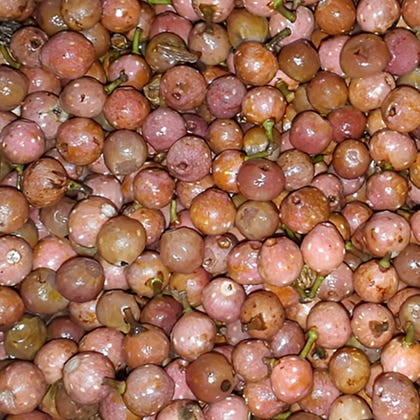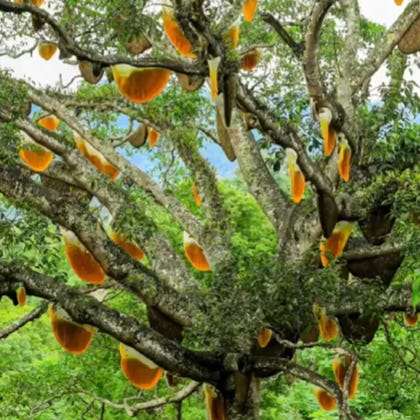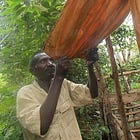Planet Ficus Monthly Roundup #3
Canopy orangutans. New fig species. Invading wasps. A fig city. Heritage trees. Feeding hornbills. A Syrian memorial. Corrosion-fighting figs. And more!
Each month, I’ll bring you stories from around the world that reveal just how extraordinary fig trees are — not just biologically, but culturally, spiritually and artistically.
In this roundup, you’ll find endangered fig-eating wildlife in Borneo and India, six newly identified fig species, a Chinese city of fig trees, invasive figs and associated insects in Europe, surprising uses of fig trees — and much more.
This variety is not random — it’s evidence that fig trees are everywhere in the human story and central to many ecosystems and cultures.
My mission with these roundups is simple: To show you that fig trees are the most interesting, important and awe-inspiring plants on the planet. Thanks for joining me on this journey. I hope these stories surprise and delight you, and maybe even change the way you see the natural world.
Let’s dive in.
New Species of Fig Trees
The list of fig species continues to grow. Botanists described a new species from South America that they have named Ficus sytsmae.
Meanwhile, scientists in India described a new species called Ficus naikii, which they assess to be critically endangered.
And in Malaysian Borneo, scientists described four new species of ‘earth figs’. These are among the world’s most unusual Ficus species — they produce their figs at ground level, or even underground.
Picture This
China’s Xinhua news agency published a video clip showing many honey-laden hives wild bees hanging from the branches of a fig tree in Yunnan province that is reputed to be a thousand years old — see the image below or watch the video.
Biodiversity, Ecology and Conservation
Last month’s roundup mentioned conservationists in Borneo installing cameras in the crowns of strangler figs to record the visiting wildlife. In a new story, Carolyn Cowan shared some of the images the cameras captured — including shots of critically endangered orangutans and helmeted hornbills.
The camera traps provide yet more evidence that strangler figs are crucial to the health of tropical forests, attracting and sustaining many species of wildlife. “These are high-value trees which should never be cut down,” said Shavez Cheema of 1StopBorneo Wildlife in Carolyn’s article.
Researchers in Indonesia identified several fig species suitable for use in projects restoring degraded forests. They call for Ficus species to be integrated into land rehabilitation strategies to boost the recovery of forest ecosystems.
In India, a new centre set up to conserve large birds called hornbills plans to do just that. As the New Indian Express reported on 22 July, it will grow fig trees in a nursery and plant them out to restore degraded forest land.
Also in India, the state government of Uttar Pradesh has committed to caring for nearly 800 wild fig trees (Ficus religiosa and Ficus benghalensis) that are more than a century old, through its Heritage Tree Adoption Scheme.
“Let the next celebrity endorsement be not a billboard, but a native fig tree planted in public memory” — writing for the The Citizen newspaper in Kenya, Enock Bii makes a compelling case for tree-planting as a civic duty. And as I am bound to say, there are no better trees to plant than native figs.
Edible Figs Old and New
Zhang Weilan reported from Xinjiang, China, where a fig industry is booming at the edge of the Gobi Desert and transforming the local economy. In one village there, nearly every house has a fig tree in its backyard. Recent investment has modernized and scaled up production of Ficus carica figs.
A company representative told Zhang of plans to expand to 50,000 acres and involve 20,000 farming households within five years, generating the equivalent of nearly US$300 million.
Researchers in Brazil published a paper making the case for developing a wild fig species from the Amazon (Ficus subapiculata) as an ingredient in the food industry, because of its high concentration of minerals and bioactive compounds.

Invasive Figs and Insect Intrigue
New research brings a warning about invasive fig species in Spain. It shows that non-native figs planted there as ornamental, shade-giving street trees can now spread on their own. That’s because the trees have been joined by their tiny pollinator wasps, so can now produce seeds.
In July, scientists reported the country’s first records of the pollinators of three fig species introduced from Asia and Australia. They also found evidence that the trees are reproducing, with seeds — likely dispersed by birds, germinating on buildings, pavements and other urban infrastructure — and they warn that this could become an expensive problem.
In Greece, scientists reported the country’s first record of an invasive pest called the Ficus whitefly — by feeding on the leaves of some species of fig trees, the whitefly can cause severe defoliation or cause branches to die. The species comes from Southeast Asia and has spread to most of the world.
The whiteflies in Greece had infested two Asian fig species introduced as ornamentals. But the insects didn’t arrive alone. The new research reports that they have been followed to Greece by one of their natural enemies — a wasp that lays its eggs inside the bodies of the whiteflies.
Innovations and Surprising Uses
In case you missed it, I wrote about new research showing that wild fig species in Kenya turn partially to stone — locking away carbon effectively forever and boosting soil health, making them prime candidates for agroforestry and reforestation initiatives.
Researchers in Thailand used an extract of Ficus pumila seeds to create eco-friendly and biodegradable microcapsules for delivering probiotics to livestock in their feed.
Engineers in Nigeria showed that coating steel pipes with the exudate of Ficus trichopoda bark and stems protected the pipes from severe corrosion, making this a potential plant-based alternative to chemical treatments for underground pipes.
A City of Fig Trees
Visit the city of Fuzhou in China and you will see many ancient fig trees of a species called the Chinese banyan (Ficus microcarpa). There are so many that the city has been nicknamed Rongcheng — meaning “City of Banyans”. I learned why in a story published on 27 July by Bastille Post.
The story traces the nickname back 900 years, to a time when the city suffered hot summers and frequent floods. In an enlightened move, the local governor Zhang Boyu decreed that “the city should be green, and no parasols should be needed in summer”. Families were encouraged to plant banyan trees, some of which are believed to be alive still today among 30,000 of their kind.
Figs in Culture, Story and Memory
On a rocky hillside in Syria’s Qalamoun Mountains, the Garden of Figs is a new initiative honouring people who have been forcibly disappeared. Wooden plaques bearing the names of the missing hang from the fig trees, creating a space for remembrance and hopes of return.
In the Philippines, balete is the name given to several species of strangler figs. In July, a play of the same name — based on a book called Tree — won ten prizes at a national theatrical awards ceremony. The play is set in a hollowed-out balete tree, a metaphor for the constancy of deep-rooted structures within which people’s lives play out.
Listen to Amanda Holmes reading The Fig Tree by award-winning poet Ruth Stone.
Reader Responses
After I wrote about a giant banyan tree in India last week (here), Doug Still contacted me to share an episode of his This Old Tree podcast about the very same tree. Doug travelled to India to visit the tree and learn about the poet-saint Kabir for whom the tree is named — a fascinating figure who should be better known outside of India. You can listen to the episode here. It is a wonderful piece of radio.
Over To You
Do you have a memory, photo, or observation involving fig trees? I’d love to hear from you. Send your story or image to planetficus@substack.com — I’ll feature selected entries in future editions. Thanks for reading!







